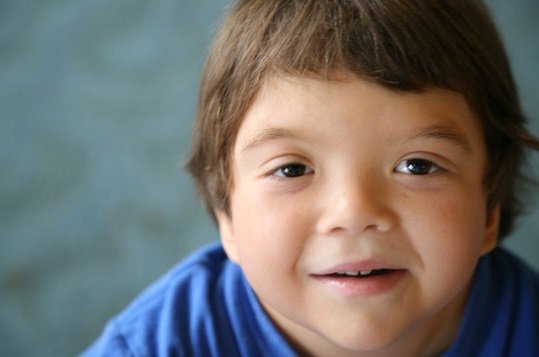What is Klinefelter Syndrome?

Klinefelter syndrome is a chromosomal anomaly that occurs only in boys. Those born with this syndrome come into this world with a preexisting genetic mutation. Where they should have one X and one Y chromosome, they have two or more X’s and one Y.
At a glance, it can be difficult to see how this could affect the child. However, the syndrome does have noticeable effects. In fact, since it occurs during the formation of the fetus, this chromosomal anomaly is the cause of 50% of miscarriages.
Despite the chromosomal error, many pregnancies go ahead without complications. In this case, the babies with the anomaly are born with specific characteristics. Let’s see what they are.
Causes of Klinefelter syndrome
There is no way to predict this chromosomal illness. The error occurs when the child is still an embryo; that is, before the first cell divisions of the zygote.
If female, chromosome division results in two X chromosomes (XX), while for males, the combination is XY. Therefore, the existence of an additional chromosome is classified as an error.
In Klinefelter syndrome in particular, the extra chromosome is an X; that is, the female chromosome. There is a certain probability that the mutation will produce other combinations, with alterations such as XXXY, XXXXY and even more.
These combinations can be isolated as the zygote divides; however, they increase with certain characteristics, such as the mother’s age. At the first round of prenatal tests, there may be a suspicion of high risk.
If risk factors are present, amniocentesis is carried out; this is the main procedure to detect the problem.
Some specialists are particularly wary when they find out that there are cases of Klinefelter syndrome in the patient’s family. Genetic inheritance is among the causes of the syndrome, and cannot be overlooked when dealing with chromosomal issues.

Symptoms of the illness
The possible combinations that this alteration can cause are manifested in sufferers. Children born with this condition have serious and identifiable anomalies. Among the most common signs are:
- Malformations in the chest and genitals
- Metabolic issues
- Sterility
- Muscle weakness
- Motor deficiencies, which make crawling and walking more difficult, although not impossible.
- Clumsy movements and lack of strength
- Delays in the learning process. For example, children with this syndrome take longer to learn to read and write and have problems understanding written and spoken language. In some cases they never learn to talk correctly. Despite these difficulties, intellectual disabilities have not been identified.
- They may develop a body structure with feminine characteristics. Their hips may widen, breasts may develop, genital alterations are possible and they are commonly overweight. Given that most of these changes occur due to puberty, it is at this stage that the most acute symptoms appear; that is, between the ages of 14 and 21.
Treatment of Klinefelter syndrome

As an unpredictable and difficult-to-diagnose anomaly, Klinefelter syndrome is not treatable. That is, there is no drug or medical procedure that will reverse the illness. However, most of the symptoms can be effectively treated.
Some of the symptoms of the condition can have real consequences, but these can be avoided. For example, if feminine traits develop, these can be minimized through surgery. Similarly, they can be reduced through the use of hormone treatments.
The chromosomal characteristics of these patients may be unaltered, so they can have normal children. Up to now, at least a hundred cases are known in which the semen of affected males was used for in vitro fertilization. Studies are being carried out to find out whether they can conceive artificially.
Cover image courtesy of spencephotography.co.uk
Klinefelter syndrome is a chromosomal anomaly that occurs only in boys. Those born with this syndrome come into this world with a preexisting genetic mutation. Where they should have one X and one Y chromosome, they have two or more X’s and one Y.
At a glance, it can be difficult to see how this could affect the child. However, the syndrome does have noticeable effects. In fact, since it occurs during the formation of the fetus, this chromosomal anomaly is the cause of 50% of miscarriages.
Despite the chromosomal error, many pregnancies go ahead without complications. In this case, the babies with the anomaly are born with specific characteristics. Let’s see what they are.
Causes of Klinefelter syndrome
There is no way to predict this chromosomal illness. The error occurs when the child is still an embryo; that is, before the first cell divisions of the zygote.
If female, chromosome division results in two X chromosomes (XX), while for males, the combination is XY. Therefore, the existence of an additional chromosome is classified as an error.
In Klinefelter syndrome in particular, the extra chromosome is an X; that is, the female chromosome. There is a certain probability that the mutation will produce other combinations, with alterations such as XXXY, XXXXY and even more.
These combinations can be isolated as the zygote divides; however, they increase with certain characteristics, such as the mother’s age. At the first round of prenatal tests, there may be a suspicion of high risk.
If risk factors are present, amniocentesis is carried out; this is the main procedure to detect the problem.
Some specialists are particularly wary when they find out that there are cases of Klinefelter syndrome in the patient’s family. Genetic inheritance is among the causes of the syndrome, and cannot be overlooked when dealing with chromosomal issues.

Symptoms of the illness
The possible combinations that this alteration can cause are manifested in sufferers. Children born with this condition have serious and identifiable anomalies. Among the most common signs are:
- Malformations in the chest and genitals
- Metabolic issues
- Sterility
- Muscle weakness
- Motor deficiencies, which make crawling and walking more difficult, although not impossible.
- Clumsy movements and lack of strength
- Delays in the learning process. For example, children with this syndrome take longer to learn to read and write and have problems understanding written and spoken language. In some cases they never learn to talk correctly. Despite these difficulties, intellectual disabilities have not been identified.
- They may develop a body structure with feminine characteristics. Their hips may widen, breasts may develop, genital alterations are possible and they are commonly overweight. Given that most of these changes occur due to puberty, it is at this stage that the most acute symptoms appear; that is, between the ages of 14 and 21.
Treatment of Klinefelter syndrome

As an unpredictable and difficult-to-diagnose anomaly, Klinefelter syndrome is not treatable. That is, there is no drug or medical procedure that will reverse the illness. However, most of the symptoms can be effectively treated.
Some of the symptoms of the condition can have real consequences, but these can be avoided. For example, if feminine traits develop, these can be minimized through surgery. Similarly, they can be reduced through the use of hormone treatments.
The chromosomal characteristics of these patients may be unaltered, so they can have normal children. Up to now, at least a hundred cases are known in which the semen of affected males was used for in vitro fertilization. Studies are being carried out to find out whether they can conceive artificially.
Cover image courtesy of spencephotography.co.uk
All cited sources were thoroughly reviewed by our team to ensure their quality, reliability, currency, and validity. The bibliography of this article was considered reliable and of academic or scientific accuracy.
- López-Siguero, J. P. (2014). Manejo del paciente con síndrome de Klinefelter. Rev Esp Endocrinol Pediatr, 5, 85-90.
- Pacenza, N., Pasqualini, T., Gottlieb, S., Knoblovits, P., Costanzo, P., Stewart Usher, J., … & Aszpis, S. (2010). Síndrome de Klinefelter en las distintas edades: experiencia multicéntrica. Revista argentina de endocrinología y metabolismo, 47(4), 29-39.
This text is provided for informational purposes only and does not replace consultation with a professional. If in doubt, consult your specialist.








